Achuta Kadambi
MorphoSim: An Interactive, Controllable, and Editable Language-guided 4D World Simulator
Oct 05, 2025



Abstract:World models that support controllable and editable spatiotemporal environments are valuable for robotics, enabling scalable training data, repro ducible evaluation, and flexible task design. While recent text-to-video models generate realistic dynam ics, they are constrained to 2D views and offer limited interaction. We introduce MorphoSim, a language guided framework that generates 4D scenes with multi-view consistency and object-level controls. From natural language instructions, MorphoSim produces dynamic environments where objects can be directed, recolored, or removed, and scenes can be observed from arbitrary viewpoints. The framework integrates trajectory-guided generation with feature field dis tillation, allowing edits to be applied interactively without full re-generation. Experiments show that Mor phoSim maintains high scene fidelity while enabling controllability and editability. The code is available at https://github.com/eric-ai-lab/Morph4D.
Feature4X: Bridging Any Monocular Video to 4D Agentic AI with Versatile Gaussian Feature Fields
Mar 26, 2025Abstract:Recent advancements in 2D and multimodal models have achieved remarkable success by leveraging large-scale training on extensive datasets. However, extending these achievements to enable free-form interactions and high-level semantic operations with complex 3D/4D scenes remains challenging. This difficulty stems from the limited availability of large-scale, annotated 3D/4D or multi-view datasets, which are crucial for generalizable vision and language tasks such as open-vocabulary and prompt-based segmentation, language-guided editing, and visual question answering (VQA). In this paper, we introduce Feature4X, a universal framework designed to extend any functionality from 2D vision foundation model into the 4D realm, using only monocular video input, which is widely available from user-generated content. The "X" in Feature4X represents its versatility, enabling any task through adaptable, model-conditioned 4D feature field distillation. At the core of our framework is a dynamic optimization strategy that unifies multiple model capabilities into a single representation. Additionally, to the best of our knowledge, Feature4X is the first method to distill and lift the features of video foundation models (e.g. SAM2, InternVideo2) into an explicit 4D feature field using Gaussian Splatting. Our experiments showcase novel view segment anything, geometric and appearance scene editing, and free-form VQA across all time steps, empowered by LLMs in feedback loops. These advancements broaden the scope of agentic AI applications by providing a foundation for scalable, contextually and spatiotemporally aware systems capable of immersive dynamic 4D scene interaction.
InstantRestore: Single-Step Personalized Face Restoration with Shared-Image Attention
Dec 09, 2024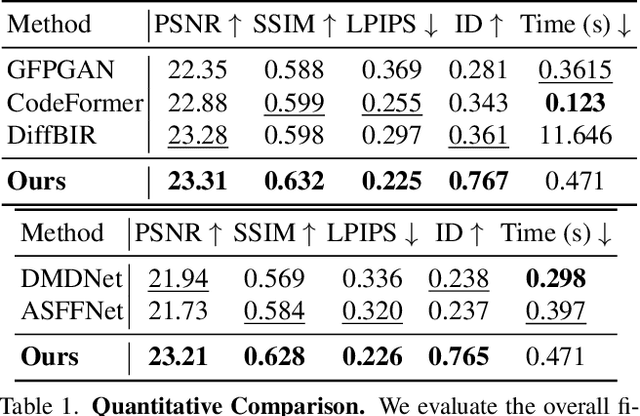
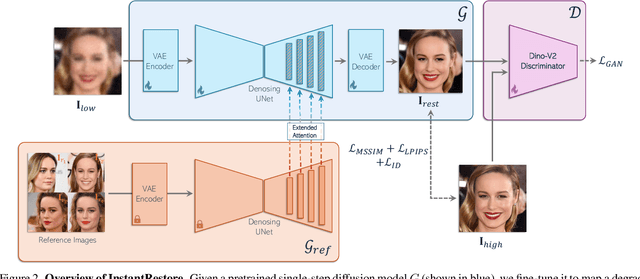
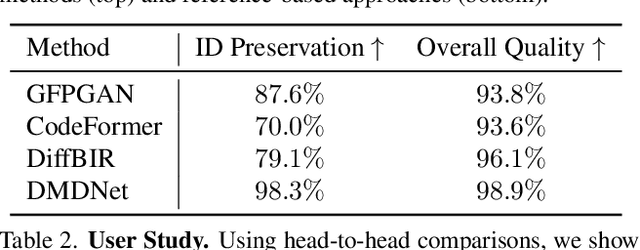
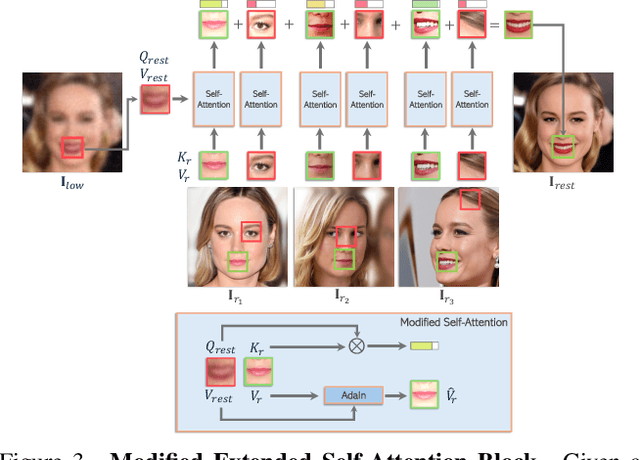
Abstract:Face image restoration aims to enhance degraded facial images while addressing challenges such as diverse degradation types, real-time processing demands, and, most crucially, the preservation of identity-specific features. Existing methods often struggle with slow processing times and suboptimal restoration, especially under severe degradation, failing to accurately reconstruct finer-level identity details. To address these issues, we introduce InstantRestore, a novel framework that leverages a single-step image diffusion model and an attention-sharing mechanism for fast and personalized face restoration. Additionally, InstantRestore incorporates a novel landmark attention loss, aligning key facial landmarks to refine the attention maps, enhancing identity preservation. At inference time, given a degraded input and a small (~4) set of reference images, InstantRestore performs a single forward pass through the network to achieve near real-time performance. Unlike prior approaches that rely on full diffusion processes or per-identity model tuning, InstantRestore offers a scalable solution suitable for large-scale applications. Extensive experiments demonstrate that InstantRestore outperforms existing methods in quality and speed, making it an appealing choice for identity-preserving face restoration.
2-Factor Retrieval for Improved Human-AI Decision Making in Radiology
Nov 30, 2024Abstract:Human-machine teaming in medical AI requires us to understand to what degree a trained clinician should weigh AI predictions. While previous work has shown the potential of AI assistance at improving clinical predictions, existing clinical decision support systems either provide no explainability of their predictions or use techniques like saliency and Shapley values, which do not allow for physician-based verification. To address this gap, this study compares previously used explainable AI techniques with a newly proposed technique termed '2-factor retrieval (2FR)', which is a combination of interface design and search retrieval that returns similarly labeled data without processing this data. This results in a 2-factor security blanket where: (a) correct images need to be retrieved by the AI; and (b) humans should associate the retrieved images with the current pathology under test. We find that when tested on chest X-ray diagnoses, 2FR leads to increases in clinician accuracy, with particular improvements when clinicians are radiologists and have low confidence in their decision. Our results highlight the importance of understanding how different modes of human-AI decision making may impact clinician accuracy in clinical decision support systems.
Large Spatial Model: End-to-end Unposed Images to Semantic 3D
Oct 24, 2024



Abstract:Reconstructing and understanding 3D structures from a limited number of images is a well-established problem in computer vision. Traditional methods usually break this task into multiple subtasks, each requiring complex transformations between different data representations. For instance, dense reconstruction through Structure-from-Motion (SfM) involves converting images into key points, optimizing camera parameters, and estimating structures. Afterward, accurate sparse reconstructions are required for further dense modeling, which is subsequently fed into task-specific neural networks. This multi-step process results in considerable processing time and increased engineering complexity. In this work, we present the Large Spatial Model (LSM), which processes unposed RGB images directly into semantic radiance fields. LSM simultaneously estimates geometry, appearance, and semantics in a single feed-forward operation, and it can generate versatile label maps by interacting with language at novel viewpoints. Leveraging a Transformer-based architecture, LSM integrates global geometry through pixel-aligned point maps. To enhance spatial attribute regression, we incorporate local context aggregation with multi-scale fusion, improving the accuracy of fine local details. To tackle the scarcity of labeled 3D semantic data and enable natural language-driven scene manipulation, we incorporate a pre-trained 2D language-based segmentation model into a 3D-consistent semantic feature field. An efficient decoder then parameterizes a set of semantic anisotropic Gaussians, facilitating supervised end-to-end learning. Extensive experiments across various tasks show that LSM unifies multiple 3D vision tasks directly from unposed images, achieving real-time semantic 3D reconstruction for the first time.
Thermal Imaging and Radar for Remote Sleep Monitoring of Breathing and Apnea
Jul 16, 2024Abstract:Polysomnography (PSG), the current gold standard method for monitoring and detecting sleep disorders, is cumbersome and costly. At-home testing solutions, known as home sleep apnea testing (HSAT), exist. However, they are contact-based, a feature which limits the ability of some patient populations to tolerate testing and discourages widespread deployment. Previous work on non-contact sleep monitoring for sleep apnea detection either estimates respiratory effort using radar or nasal airflow using a thermal camera, but has not compared the two or used them together. We conducted a study on 10 participants, ages 34 - 78, with suspected sleep disorders using a hardware setup with a synchronized radar and thermal camera. We show the first comparison of radar and thermal imaging for sleep monitoring, and find that our thermal imaging method outperforms radar significantly. Our thermal imaging method detects apneas with an accuracy of 0.99, a precision of 0.68, a recall of 0.74, an F1 score of 0.71, and an intra-class correlation of 0.70; our radar method detects apneas with an accuracy of 0.83, a precision of 0.13, a recall of 0.86, an F1 score of 0.22, and an intra-class correlation of 0.13. We also present a novel proposal for classifying obstructive and central sleep apnea by leveraging a multimodal setup. This method could be used accurately detect and classify apneas during sleep with non-contact sensors, thereby improving diagnostic capacities in patient populations unable to tolerate current technology.
Solutions to Deepfakes: Can Camera Hardware, Cryptography, and Deep Learning Verify Real Images?
Jul 04, 2024Abstract:The exponential progress in generative AI poses serious implications for the credibility of all real images and videos. There will exist a point in the future where 1) digital content produced by generative AI will be indistinguishable from those created by cameras, 2) high-quality generative algorithms will be accessible to anyone, and 3) the ratio of all synthetic to real images will be large. It is imperative to establish methods that can separate real data from synthetic data with high confidence. We define real images as those that were produced by the camera hardware, capturing a real-world scene. Any synthetic generation of an image or alteration of a real image through generative AI or computer graphics techniques is labeled as a synthetic image. To this end, this document aims to: present known strategies in detection and cryptography that can be employed to verify which images are real, weight the strengths and weaknesses of these strategies, and suggest additional improvements to alleviate shortcomings.
4K4DGen: Panoramic 4D Generation at 4K Resolution
Jun 19, 2024
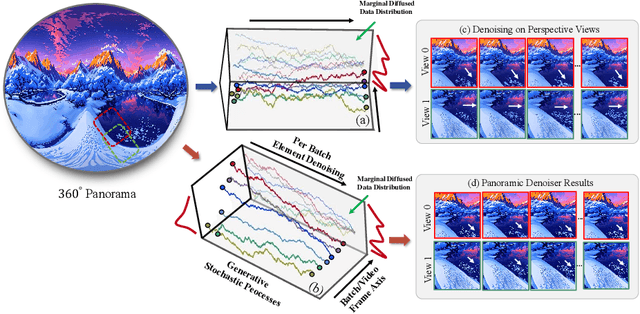

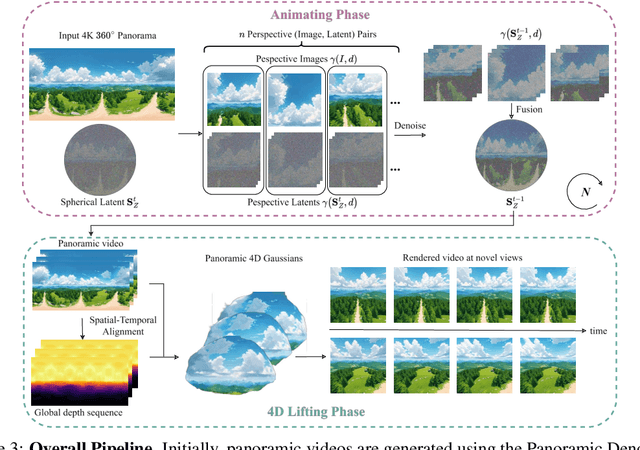
Abstract:The blooming of virtual reality and augmented reality (VR/AR) technologies has driven an increasing demand for the creation of high-quality, immersive, and dynamic environments. However, existing generative techniques either focus solely on dynamic objects or perform outpainting from a single perspective image, failing to meet the needs of VR/AR applications. In this work, we tackle the challenging task of elevating a single panorama to an immersive 4D experience. For the first time, we demonstrate the capability to generate omnidirectional dynamic scenes with 360-degree views at 4K resolution, thereby providing an immersive user experience. Our method introduces a pipeline that facilitates natural scene animations and optimizes a set of 4D Gaussians using efficient splatting techniques for real-time exploration. To overcome the lack of scene-scale annotated 4D data and models, especially in panoramic formats, we propose a novel Panoramic Denoiser that adapts generic 2D diffusion priors to animate consistently in 360-degree images, transforming them into panoramic videos with dynamic scenes at targeted regions. Subsequently, we elevate the panoramic video into a 4D immersive environment while preserving spatial and temporal consistency. By transferring prior knowledge from 2D models in the perspective domain to the panoramic domain and the 4D lifting with spatial appearance and geometry regularization, we achieve high-quality Panorama-to-4D generation at a resolution of (4096 $\times$ 2048) for the first time. See the project website at https://4k4dgen.github.io.
All-day Depth Completion
May 27, 2024



Abstract:We propose a method for depth estimation under different illumination conditions, i.e., day and night time. As photometry is uninformative in regions under low-illumination, we tackle the problem through a multi-sensor fusion approach, where we take as input an additional synchronized sparse point cloud (i.e., from a LiDAR) projected onto the image plane as a sparse depth map, along with a camera image. The crux of our method lies in the use of the abundantly available synthetic data to first approximate the 3D scene structure by learning a mapping from sparse to (coarse) dense depth maps along with their predictive uncertainty - we term this, SpaDe. In poorly illuminated regions where photometric intensities do not afford the inference of local shape, the coarse approximation of scene depth serves as a prior; the uncertainty map is then used with the image to guide refinement through an uncertainty-driven residual learning (URL) scheme. The resulting depth completion network leverages complementary strengths from both modalities - depth is sparse but insensitive to illumination and in metric scale, and image is dense but sensitive with scale ambiguity. SpaDe can be used in a plug-and-play fashion, which allows for 25% improvement when augmented onto existing methods to preprocess sparse depth. We demonstrate URL on the nuScenes dataset where we improve over all baselines by an average 11.65% in all-day scenarios, 11.23% when tested specifically for daytime, and 13.12% for nighttime scenes.
DreamScene360: Unconstrained Text-to-3D Scene Generation with Panoramic Gaussian Splatting
Apr 10, 2024

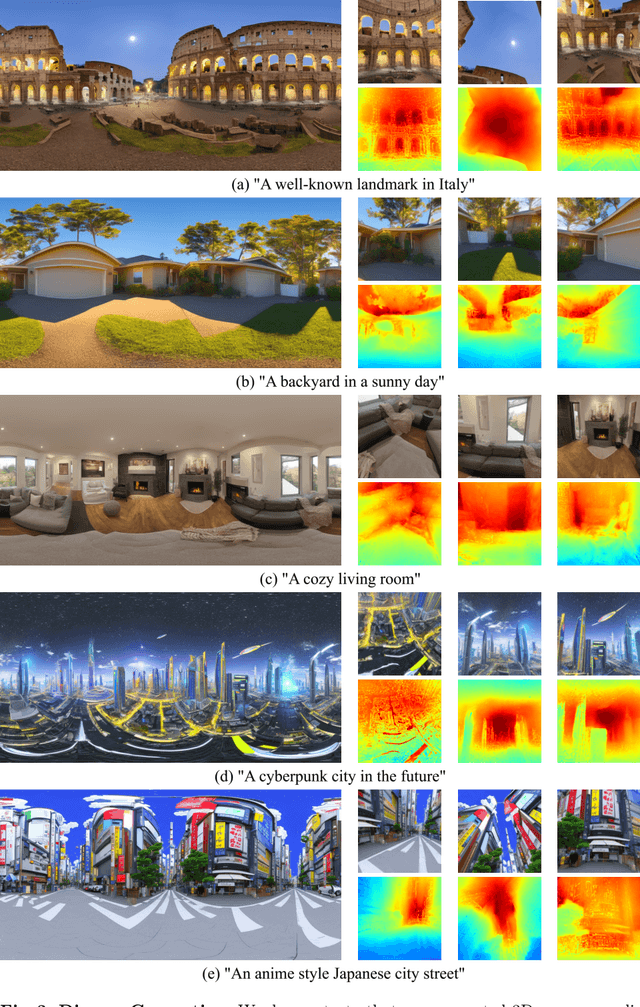
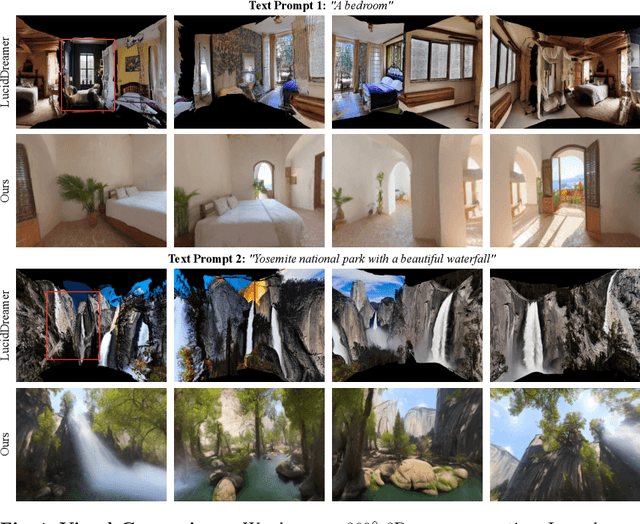
Abstract:The increasing demand for virtual reality applications has highlighted the significance of crafting immersive 3D assets. We present a text-to-3D 360$^{\circ}$ scene generation pipeline that facilitates the creation of comprehensive 360$^{\circ}$ scenes for in-the-wild environments in a matter of minutes. Our approach utilizes the generative power of a 2D diffusion model and prompt self-refinement to create a high-quality and globally coherent panoramic image. This image acts as a preliminary "flat" (2D) scene representation. Subsequently, it is lifted into 3D Gaussians, employing splatting techniques to enable real-time exploration. To produce consistent 3D geometry, our pipeline constructs a spatially coherent structure by aligning the 2D monocular depth into a globally optimized point cloud. This point cloud serves as the initial state for the centroids of 3D Gaussians. In order to address invisible issues inherent in single-view inputs, we impose semantic and geometric constraints on both synthesized and input camera views as regularizations. These guide the optimization of Gaussians, aiding in the reconstruction of unseen regions. In summary, our method offers a globally consistent 3D scene within a 360$^{\circ}$ perspective, providing an enhanced immersive experience over existing techniques. Project website at: http://dreamscene360.github.io/
 Add to Chrome
Add to Chrome Add to Firefox
Add to Firefox Add to Edge
Add to Edge